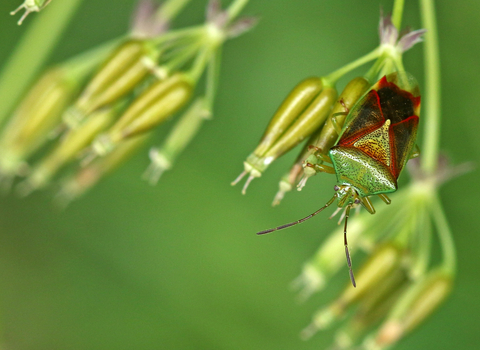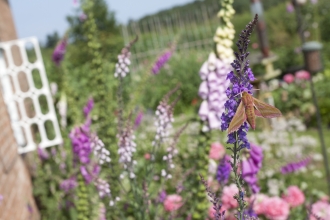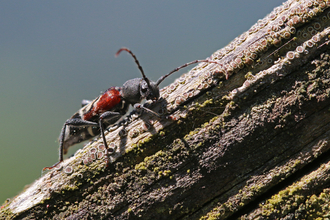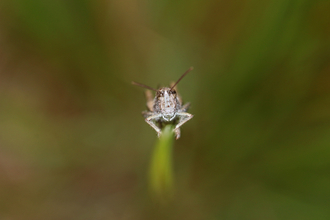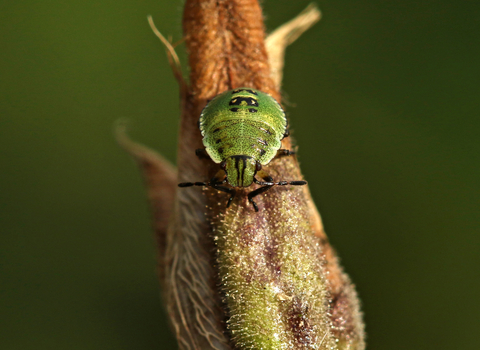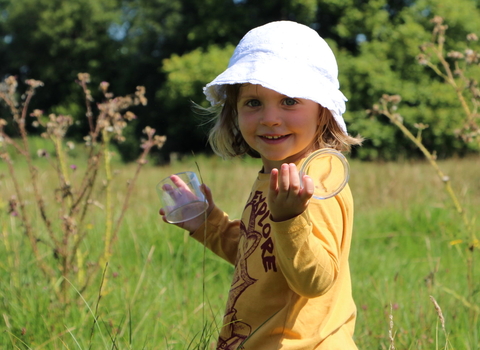With their shield-shaped body and habit of sitting openly in sunny positions in many different habitats, local bug expert, Gary Farmer, helps us to discover about some of Worcestershire's shieldbugs.
These true bugs, shieldbugs belong to the Order Hemiptera (half-wings) and have mouth parts that are modified into a long beak, known as a rostrum, for sucking fluids from plants and in some cases other insects.
They pass through an incomplete metamorphosis, hatching as miniature versions of the adults, shedding their skins several times as they grow (there is no pupal stage like butterflies). They generally overwinter as adults, emerging in spring to lay eggs with the new generation maturing at the end of the summer, ready for the cycle to start again. If threatened they release a foul smelling, bad tasting liquid, which has won them the alternative name of stink-bugs.
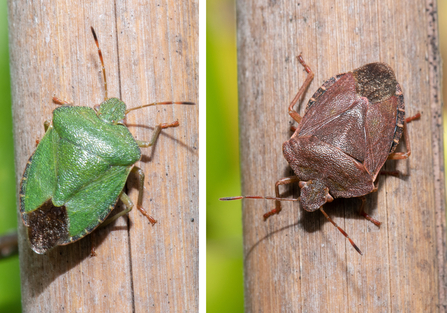
Green shieldbug - summer form (l) and winter form (r) by Gary Farmer
Green shieldbug Palomena prasina
This is the most regularly encountered shieldbug, common in many habitats, including gardens, where it will sit very openly on a leaf in the sunshine. The adults can usually be found from April to June and again from mid-August. They are bright green with a dark area where the wing membranes overlap but they turn purple/brown in time with the autumn leaves, giving them camouflage during their winter hibernation.
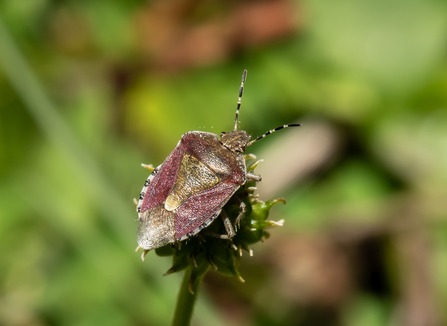
Hairy shieldbug by Gary Farmer
Hairy shieldbug/sloe bug Dolycoris baccarum
This is another common species and has two commonly used English names. Hairy shieldbug describes it well, especially the nymphs that are covered in fine hairs. Sloe bug is an odd choice of name as it can be found on a great many different plants but I have never found it on sloes. This species is often encountered on seed heads of a range of plants from buttercups to dandelions, where it can blend in remarkably well.
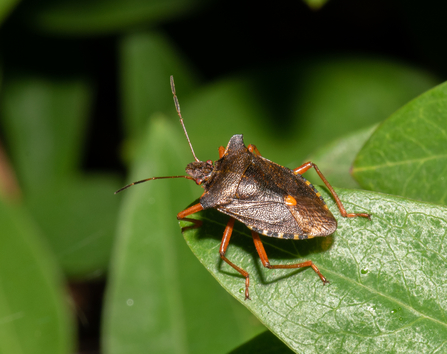
Red-legged shieldbug by Gary Farmer
Forest bug/red-legged shieldbug Pentatoma rufipes
This large, glossy dark brown shieldbug is common in shrubs and trees in many parts of the county. It has bright orange-red legs and a corresponding spot in the middle of its back. Its nymphs are mottled browns and greens and blend in perfectly with the tree bark, where they feed on sap from the tree as well as scavenging dead insects. Unusually for shieldbugs, it overwinters in the nymphal stage.
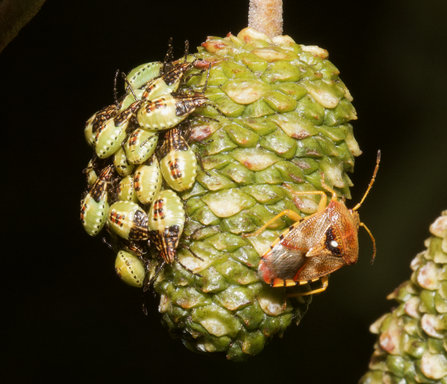
Parent bug and nymphs by Rosemary Winnall
Parent bug Elasmucha grisea
The aptly named parent bug lays its eggs, usually on birch or alder leaves, in June and then sits over them as if incubating them. She does this to keep parasites and small predators away. The mother continues to protect her brood as they grow and the sight of a mother bug sitting on nymphs all wearing what appears to be striped pyjamas is a wonder of the insect world.
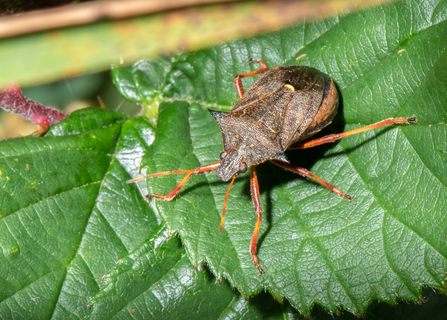
Spiked shieldbug Picromerus bidens
This is a robust predatory species, feeding mainly on the caterpillars of moths, butterflies and sawflies but it will also feed on adult insects including other shieldbugs. This dull brown bug is easily overlooked as it sits in semi-shaded areas patiently waiting for lunch. The English name comes from its sharp-pointed ‘shoulders’, which is echoed in the scientific species name bidens ‘two teeth’. Unusually for shieldbugs, spiked shieldbugs overwinter as eggs.
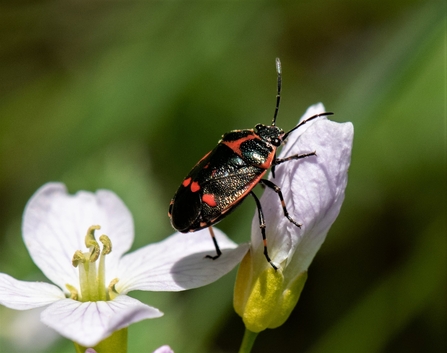
Brassica shieldbug by Gary Farmer
Brassica shieldbug Eurydema oleracea
Until recently this pretty shieldbug would have been a rare sight in Worcestershire. In recent years, though, it has been seen almost anywhere where its foodplants grow. It feeds on members of the cabbage family, ranging from horseradish to lady’s smock. This is an unusual shieldbug in that it has different colour forms. It is always shiny black but with a distinct pattern of white or red or occasionally orange patches.
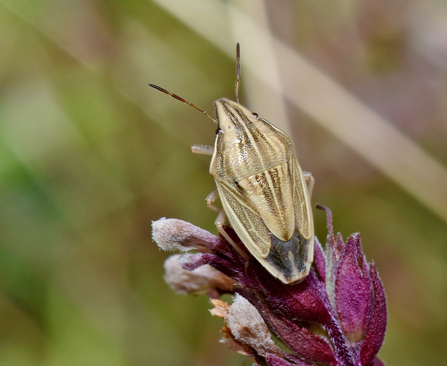
Bishop's mitre by Gary Farmer
Bishop’s mitre Aelia acuminata
Many groups of insects are expanding their range further north, especially since the end of the 20th century, and shieldbugs are no exception. The bishop’s mitre shieldbug was found for the first time in Worcestershire in 2001 and there has been a rapid increase in their distribution and number. Search in grassland in summer for this is a slim shieldbug, which supposedly resembles the ceremonial headgear (or mitre) of a bishop.
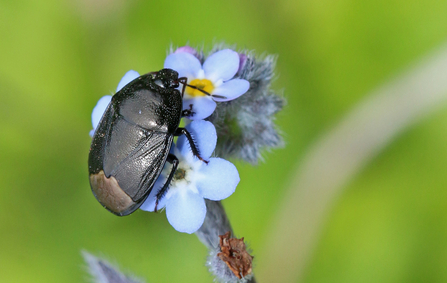
Forget-me-not shieldbug by Wendy Carter
Forget-me-not shieldbug Sehirus luctuosus
This is one of several small black shieldbugs that at first glance could be mistaken for a beetle. Closer examination will reveal the wing membranes and rostrum that are characteristic of the true bugs. It would appear to be uncommon in Worcestershire but if you have forget-me-nots in your garden it’s worth looking on the ground beneath plants, especially in May. It is occasionally seen climbing the foodplant to feed on seeds.
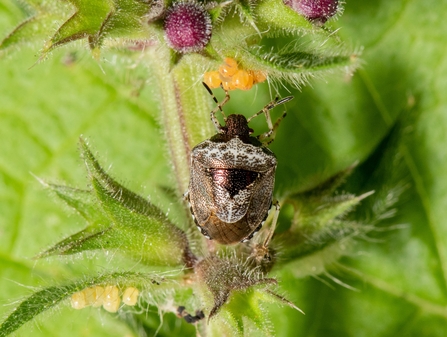
Woundwort shieldbug and eggs by Gary Farmer
Woundwort shieldbug Eysarcoris venustissimus
Allow hedge woundwort to grow in a sunny spot in your garden and you will almost certainly be rewarded by the sight of these little bugs, looking like pieces of polished bronze sitting on the flat leaves. They can be found at all life stages through most of the summer with adults only really absent between generations in July, overwintering in the soil below the plant. You can discover more about these small shieldbugs in our short woundwort shieldbug video.

